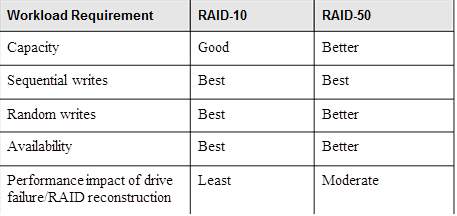More Spindles Means More IOPS? RAID10 vs RAID50
I’ve asked Equallogic Support the following question today, it turns out I had wrong understanding about RAID10 before.
Client enviornment is running VMWare using EQL PS6000XV, 16 15K RPM disks (ie, 14 disks + 2 hot-spares)
In RAID10, there are 7 spindles as RAID10 only ultilizes half the disks, so there are only 7 spindles producing the atual IOPS.
In RAID50, all 14 spindles are used.
I/O pattern is mostly random (30% Read, 70% Write)
Does this mean in this case RAID50 is faster than RAID10 in terms of IOPS as there are 14 spindles in RAID50 compares to 7 spindles RAID10?
Reply from Equallogic’s US Support
The thing to remember here is that with RAID10 it will make two writes, one to each disk.With RAID50, it will need to make the read/write/parity to all of the member disks in the raidset.With Read/Write sequential IO, the difference would be minimal. With an environment as you described (virtual environment) where there are many small random I/Os, RAID10 will be quicker.
RAID10 will also be quicker if a drive fails whereas the performance with RAID5/50 is poor when the raidset is degraded and a rebuild is going on.
And of course, the space issue when considering RAID10 or RAID50 is a huge consideration
Then, I got an even better answer from a Dell storage expert in Hong Kong
Actually spindle in RAID10 is still 14, not 7; 7 is the capacity oriented view. We still consider using all disks during I/O.
But you may notice that above chart didn’t mention for Read performance? And yes, read performance for RAID 10 and RAID 50 or even RAID-5 will almost the same! The different will mainly focus on write.
RAID 50 is two RAID-5 and stripe, the RAID parity overhead will still exist across the disks; the more disks you have in the RAID group, the more overhead and performance penalty you have!
In RAID 10, every RAID group consists with two disks only, so overhead and performance penalty is minimum.

Did you try SAN HQ ?
There is a feature call Experimental Analysis which can monitor IO utilization.
Also, since version 2.2, the RAID Evaluator also help to compare different RAID type.
The Max IOPS is depends on how client access.
Also, did you try disable logging of guest ?
Thanks, actually I upgraded SANHQ to v2.2 this week and played a bit on RAID Evaluator and Live View (http://www.modelcar.hk/?p=5071).
To summerize in terms of IOPS:
RAID10
Read: I/O will be produced from 7 spindles only. (ie, there are RAID1 disks x 7)
Write: I/O will be written to 7 spindles only, but replicated across the mirror disk in the same time (no overhead).
RAID50
Read: I/O will be produced from all 14 spindles. (ie, there are RAID5 disks x 2)
Write: I/O will be written to all 14 spindles, so there are overhead in each RAID5 group which consists of 7 spindles each plus parity calculation.
So I would still think RAID10 is faster in Write only by at least 40-50% (this is proved in the new SANHQ 2.2 RAID Evaluator feature), but RAID50 should be faster in terms of Read, but due to overhead plus parity, it’s almost the same as RAID10.
Btw, you are the 2nd guy (1st guy is Andy) I know who uses EQL in Hong Kong, my Dell sales told me they have sold over 100 units in HK last year which I seriously doubt it’s true. My 6th sense told me there are actually only a small group of people using EQL in Hong Kong, probably less than 50 units in total.
Anyway, it would be nice if we can form a small local EQL User Group and get together sometime and share things we are crazy about. I mean EQL, VMWare, Windows, Netscreen, Email Server, IOPS, SQL Server, IDS, Monitoring tools, basically how to make a system admin life much easier are all welcome, of course, if you love model cars or tennis will be even better.